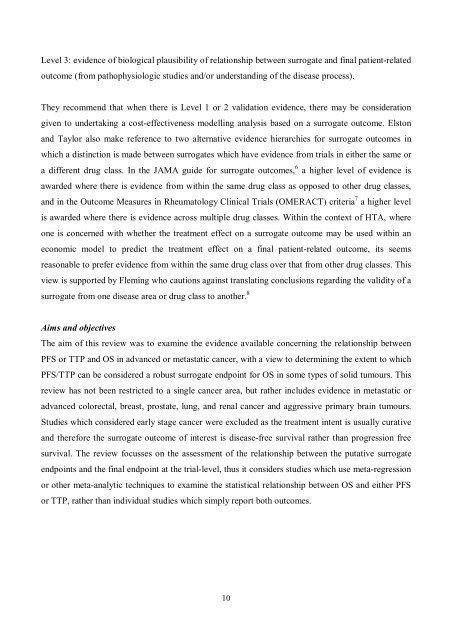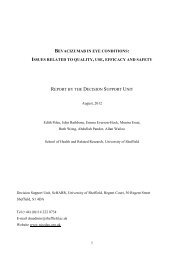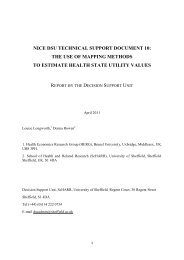A review of studies examining the relationship between progression ...
A review of studies examining the relationship between progression ...
A review of studies examining the relationship between progression ...
You also want an ePaper? Increase the reach of your titles
YUMPU automatically turns print PDFs into web optimized ePapers that Google loves.
Level 3: evidence <strong>of</strong> biological plausibility <strong>of</strong> <strong>relationship</strong> <strong>between</strong> surrogate and final patient-relatedoutcome (from pathophysiologic <strong>studies</strong> and/or understanding <strong>of</strong> <strong>the</strong> disease process).They recommend that when <strong>the</strong>re is Level 1 or 2 validation evidence, <strong>the</strong>re may be considerationgiven to undertaking a cost-effectiveness modelling analysis based on a surrogate outcome. Elstonand Taylor also make reference to two alternative evidence hierarchies for surrogate outcomes inwhich a distinction is made <strong>between</strong> surrogates which have evidence from trials in ei<strong>the</strong>r <strong>the</strong> same ora different drug class. In <strong>the</strong> JAMA guide for surrogate outcomes, 6 a higher level <strong>of</strong> evidence isawarded where <strong>the</strong>re is evidence from within <strong>the</strong> same drug class as opposed to o<strong>the</strong>r drug classes,and in <strong>the</strong> Outcome Measures in Rheumatology Clinical Trials (OMERACT) criteria 7 a higher levelis awarded where <strong>the</strong>re is evidence across multiple drug classes. Within <strong>the</strong> context <strong>of</strong> HTA, whereone is concerned with whe<strong>the</strong>r <strong>the</strong> treatment effect on a surrogate outcome may be used within aneconomic model to predict <strong>the</strong> treatment effect on a final patient-related outcome, its seemsreasonable to prefer evidence from within <strong>the</strong> same drug class over that from o<strong>the</strong>r drug classes. Thisview is supported by Fleming who cautions against translating conclusions regarding <strong>the</strong> validity <strong>of</strong> asurrogate from one disease area or drug class to ano<strong>the</strong>r. 8Aims and objectivesThe aim <strong>of</strong> this <strong>review</strong> was to examine <strong>the</strong> evidence available concerning <strong>the</strong> <strong>relationship</strong> <strong>between</strong>PFS or TTP and OS in advanced or metastatic cancer, with a view to determining <strong>the</strong> extent to whichPFS/TTP can be considered a robust surrogate endpoint for OS in some types <strong>of</strong> solid tumours. This<strong>review</strong> has not been restricted to a single cancer area, but ra<strong>the</strong>r includes evidence in metastatic oradvanced colorectal, breast, prostate, lung, and renal cancer and aggressive primary brain tumours.Studies which considered early stage cancer were excluded as <strong>the</strong> treatment intent is usually curativeand <strong>the</strong>refore <strong>the</strong> surrogate outcome <strong>of</strong> interest is disease-free survival ra<strong>the</strong>r than <strong>progression</strong> freesurvival. The <strong>review</strong> focusses on <strong>the</strong> assessment <strong>of</strong> <strong>the</strong> <strong>relationship</strong> <strong>between</strong> <strong>the</strong> putative surrogateendpoints and <strong>the</strong> final endpoint at <strong>the</strong> trial-level, thus it considers <strong>studies</strong> which use meta-regressionor o<strong>the</strong>r meta-analytic techniques to examine <strong>the</strong> statistical <strong>relationship</strong> <strong>between</strong> OS and ei<strong>the</strong>r PFSor TTP, ra<strong>the</strong>r than individual <strong>studies</strong> which simply report both outcomes.10





